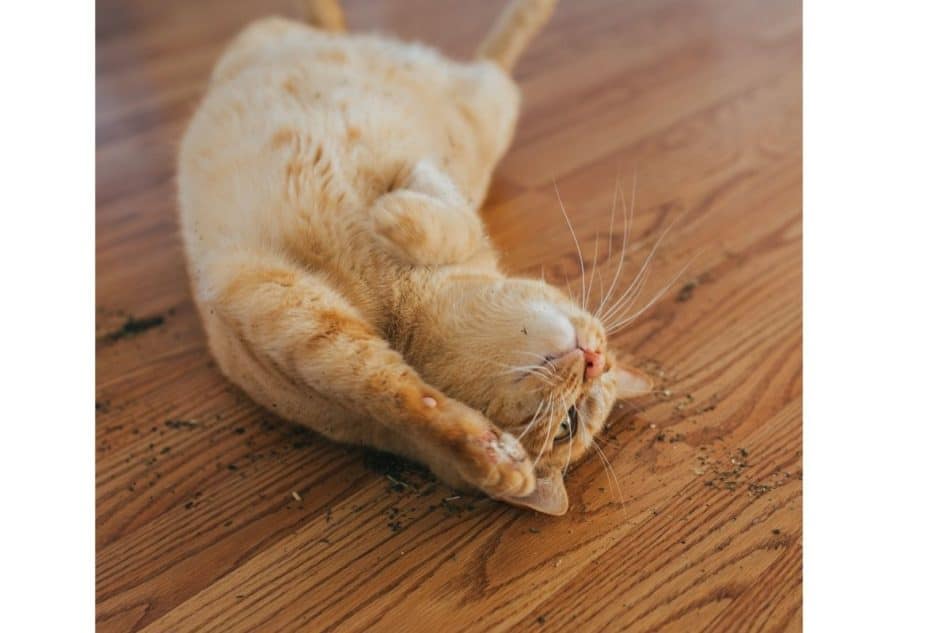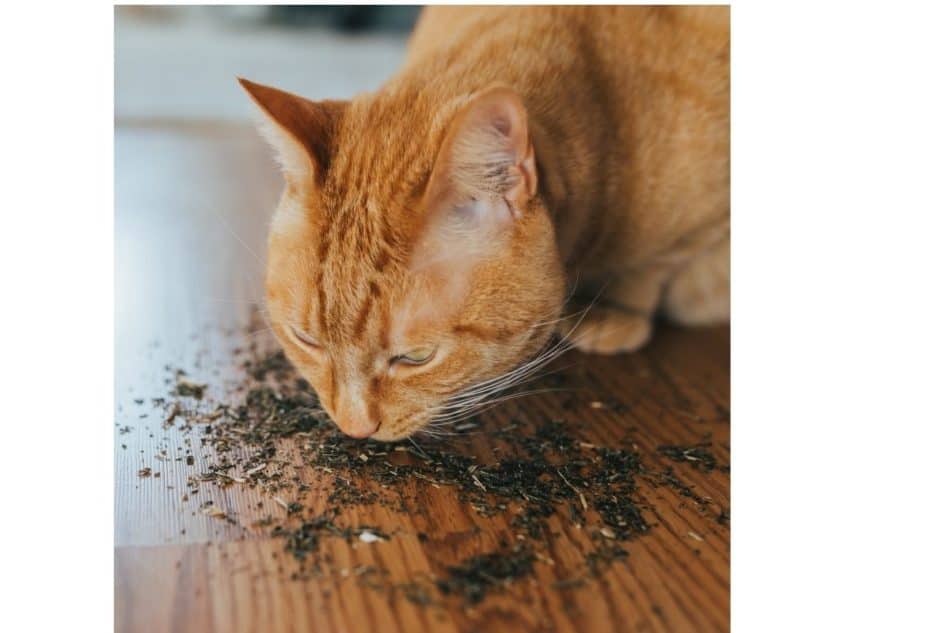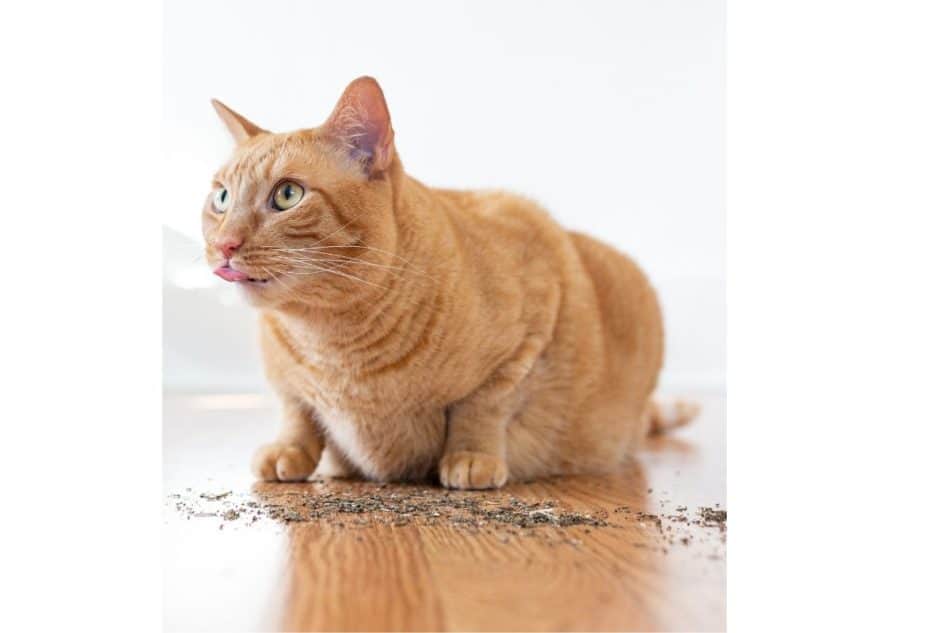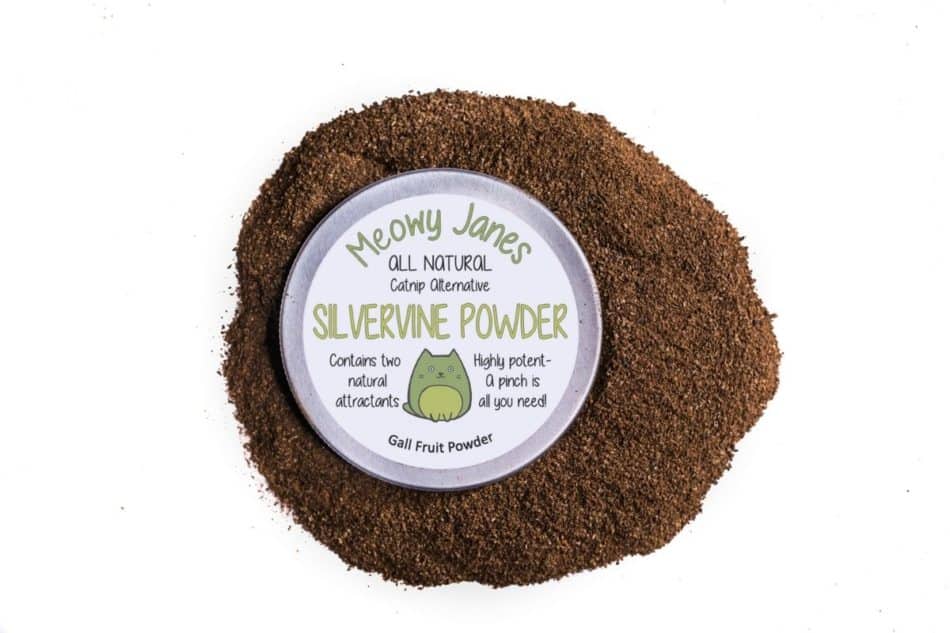Table of Contents
Introduction
I have lived with as many as eight rescue cats that were all indoor cats.
We believed it important to spend time with the kitties. We would use various toys to get them engaged in play, and we would occasionally offer them some treats.
If we really wanted to have a party, we would break out the catnip.
3 Ways Your Cat May React to Catnip
1. Rolling in the Catnip
Put some catnip on the floor and your pet may start off by sniffing the catnip and then begin rolling on the floor and rubbing its head and cheeks on the catnip as in this photo:

2. Eating the Catnip
Your cat may chew on the catnip and may eat some of it, like the kitty in the photo below:

We never saw a bad reaction from our cat eating catnip, but you should limit the amount they consume. Moderation is called for here.
Please be sure the catnip your cat is eating is pure catnip that you have provided and not catnip included inside a toy or cloth bag since that catnip may have additives that might not be safe.
3. Staring in a Sphinx-Like Pose
For many years the general consensus had been that about 1/3 of adult cats do not respond to catnip. However, a 2017 study that was published in the journal Behavioural Processes proposed that those supposed non-responders may actually be reacting with what the study authors call a passive response.
One example of a passive response is assumption of a “sphinx-like” posture like the kitty in this photo:

The catnip’s effect on your cat will last about 10 minutes or so, after which your cat will not be interested in catnip for an hour or two.
If your cat is a kitten, you will probably see no response. The age at which the reaction to catnip appears is not precisely known, and is probably variable with each cat. About six months old is a good estimate.
These active or passive reactions are triggered by your cat smelling the catnip. This is referred to as an olfactory response. Cats have a very acute sense of smell, so get out of the way if you’re standing between a cat and catnip.
7 Things to Avoid When Giving Catnip to Your Cat
1. Don’t serve catnip on an elevated surface.
Your cat may be rolling all around and focused on the catnip and as a result your pet could roll off a counter or table and be injured.
2. Don’t serve loose catnip on a carpeted surface.
Your cat could start licking the catnip and in doing so might be ingesting carpet fibers. Use a smooth wood or tile floor to serve loose catnip.
3. Don’t give catnip to kittens less than six months of age.
Kittens will most likely not be interested in catnip.
4. Don’t give catnip to a pregnant cat.
All that rolling around may not be good for a lady with kittens.
5. Don’t give catnip immediately following a first serving of catnip.
They will probably not be interested again for at least another hour or two.
6. Don’t give catnip frequently.
This is a precaution against your cat building a tolerance to catnip and losing interest.
7. Don’t serve catnip that has sticks in it.
Those sticks could scratch or possibly even choke your cat. Either remove the sticks or consider a powdered catnip product like the one shown below.

For information about this product visit the Meowy Janes website.
2 Great Ways to Give Catnip to Your Cat
1. Put some catnip in a sock and tie a knot in the upper part of the sock. Then present the sock to your kitty just as you would any cat toy.
2. Sprinkle a little catnip on a smooth wood or tile floor. This works very well for multiple cat households because you can put a little bit here and a little bit there. Then everybody has a serving.
How Long Does It Take for Catnip to Affect a Cat?
A cat’s attraction to catnip is triggered by smell, and they are really good at smelling. They will know right away that catnip is nearby. Whether their reaction is to jump on the catnip or sit and look at it, it will not take long for something to happen.
Does Catnip Expire?
Like the organic oils of most plants, neptalactone, the volatile oil in catnip, will lose potency over time. Some things you can do to make it last longer include:
- buy small quantities
- store it in a sealed container
- keep it out of direct sunlight
- don’t store it in a damp location
- put it where your cat cannot get at it
Are There Alternatives to Catnip?
There are at least three plants that have been identified as having an effect on cats that is similar to the effect caused by catnip (nepeta cataria):
- silvervine (actinidia polygama)
- valerian root (valeriana officinalis)
- Tartarian honeysuckle (lonicera tatarica)
A 2017 study published in BMC Veterinary Research measured the percentage response by the study cats to these four plant species. it is my understanding the researchers were looking at active responses, but not the passive responses that include the “sphinx-like” posturing and which were described in the study mentioned earlier in this post. Here are their findings:
- silvervine – 79%
- catnip – 68%
- Tartarian honeysuckle – 53%
- valerian root – 47%
Since we have a study that had a high percentage of cats responding to silvervine, it may be worth considering silvervine as an alternative to catnip. Here is a product you may like to consider:

For information about this product visit the Meowy Janes website.
Why Do Cats Rub Their Head on Catnip?
In 1964, Cornell University entomology researcher Thomas Eisner proposed that an oil in catnip acted as an insect repellant. Subsequent research over the years has confirmed this.
Nepetalactone is the oil in catnip that is believed to be the primary oil that prompts a reaction in cats. It is an oil known to science as an iridoid. Iridoids are natural compounds that in many plants act as a defense for the plant against insects. Nepetalactone is considered to be a mosquito repellant.
A study published in ScienceAdvances found that nepetalactol, an iridoid found in silvervine, likewise acted as a mosquito repellant.
So the question might be, when cats are rubbing their heads and cheeks on catnip or silvervine, are they acting upon some ancient instinct that informs them that this is a mosquito repellant?
I have attempted to interview cats about this and the only doggone comment I could get out of them was, and I quote, “meow”, which translated means “when do we eat”.
Does Catnip Make My Cat Happy?
I have observed on the internet much use of the word euphoria when describing a cat’s reactions to catnip. I wonder if those conclusions that catnip makes cats happy is based on the cat’s physical reaction.
It does look like they are having a good time, but how do we know what they are thinking?
I did find an article in Scientific American that reported that the neptalactone in catnip does cause a reaction in a cat’s brain that compels them to behave the way they do around catnip. As far as I can tell from reading the article, whether that behavior reflects happiness or not was not determined.
I also found research on this happiness question that examined the effect of silvervine, but not of catnip. This information is from the same study I mention above about silvervine being a mosquito repellant. That study also measured the level of beta-endorphins in five cats before and after being exposed to silvervine.
Beta-endorphins are proteins that are associated with pain relief and elevated mood. They are sometimes referred to as one of the “happiness hormones”. The study found that the cats’ level of beta-endorphins increased after exposure to silvervine.
So does one small study provide conclusive evidence that silvervine makes our cats happy? And can study results about silvervine be applied to catnip? I cannot say.
Maybe there is something going on with these plants that elicits joy. Maybe they are excited to have access to a mosquito repellant, even if they are an inside cat. Instinct is a powerful force.
All I can suggest is that you watch them and do your best to figure out if they want you to buy more catnip or silvervine for them. They are, after all, pretty good at letting you know what they want.
If You Would Like to Discover More About Cats
For more information about cats, visit my blog post Learn About Cats
